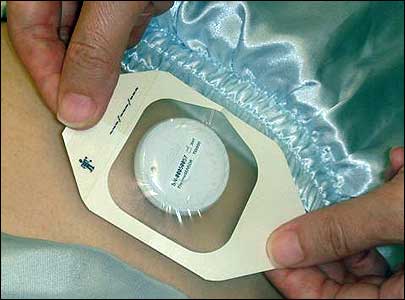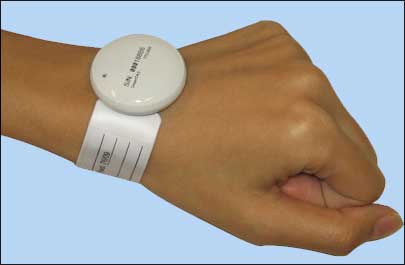Tan Tock Seng Hospital first rolled out radio frequency identification technology in 2007 to track more than 1,200 patients throughout its facility, and to be able to locate them immediately when required for testing. Now, the hospital is expanding the system to include a 3-centimeter-wide (1.2-inch-wide) active ultrahigh-frequency (UHF) tag taped to a patient’s abdomen, to monitor that individual’s body temperature and detect serious infections without waking him or her.
Yong Keng Kwang, deputy director of Tan Tock Seng Hospital’s nursing service, says the hospital is one of the country’s busiest, with more than 1,200 patients at any particular time, and with a daily occupancy rate of 90 percent.
“We believed that real-time patient tracking would help remove inefficiency associated with bed allocation and inter-departmental communication, and improve patients’ access for admission,” Yong says. “Previously, bed allocation relied heavily on regular three-way communication between the bed-management unit, emergency department and wards, but with RFID, information flows between the three parties are automatic and less dependent on verbal communication.”
In 2007, Tan Tock Seng chose Singapore-based vendor Cadi Scientific to roll out the patient-tracking system as it offered local support—an important consideration when trialing new technology. Some 556 Cadi SmartNode RFID interrogators were deployed throughout the hospital, and battery-powered SmartTags operating at 868.4 MHz were added to patients’ identification bracelets in order to track those individuals as they moved around the facility.
The system provided a number of benefits, Yong indicates, from increased staff efficiency to improved communication, faster bed turnover and reduced patient waiting times.“For example,” Yong explains, “when a patient is discharged, housekeeping and the bed-management unit are notified in real time, and the bed is cleaned within 30 minutes. With advance notice, the emergency department could also better prepare their patients for transfer. Knowing the real-time location of patient also helps. When a patient goes in for an operation, ward nurses will be able to tell when an operation has been completed by virtue of the patient’s location in the post-anesthesia care unit, and update the patient’s family.”
Given the success of that tracking system, Yong says—and the fact that its patients already wear RFID tags—it made sense for the hospital to embrace other features and make more productive use of radio frequency identification.
According to Lim Soh Min, director of Cadi Scientific, efforts to extend the system to include wireless temperature sensing and paperless vital signs commenced last month. The company developed new RFID tags, known as ThermoSensors, capable of monitoring patients’ body temperatures and tracking their locations. Extensive testing was carried out on the ThermoSensors with more than 500 patients in four hospitals. A study involving 300 patients at Tan Tock Seng Hospital was also conducted at different settings, in order to compare temperature readings with various devices, such as tympanic, digital and mercury thermometers.
“Results showed the accuracy of the ThermoSensor was comparable to that of an ear thermometer, underarm thermometer and oral thermometer with an accuracy of within 0.2 degree Celsius,” Lim says.
“Extensive tests that comply with the ISO 13485 procedure were also performed on the system, including accuracy tests, reader reception tests and system load performance tests,” Lim states, referring to the ISO standard that specifies requirements regarding the design and manufacture of medical devices.Using the system, temperature readings are performed automatically and information is continuously uploaded from the SmartNode interrogators to servers. Cadi’s SmartSense Enterprise software provides information regarding temperature and vital signs through a dashboard tool, with all vital-sign values automatically plotted on paperless clinical charts.
Laptops have replaced traditional clipboards to track a patient’s vital signs, according to Lim, and hospital officials are seeking ways to better share information between doctors, nurses and departments.
“The new wireless temperature-monitoring system is already delivering enhanced patient care, as patients have more uninterrupted rest and nurses are alerted immediately once a fever is detected,” Lim states. “It has also reduced the nurses’ workload, as they do not need to manually plot vital signs into paper clinical charts, and clinical information is readily available to doctors who can log on anytime, anywhere, to view patient clinical charts. It is a major leap towards becoming a digital hospital.”
Yong agrees that the new system already delivers benefits to the hospital, as nurses now have more time to perform other duties, such as feeding patients or managing those who need to be isolated.
“This is part of the hospital’s long-term vision to move towards paperless charting and improve access to patients’ records for health-care providers,” Yong says. “Our next move is to explore devices for automatic measurements and charting of other vital signs, such as blood pressure. There are plans to use it for equipment tracking.”
According to Yong, although it is too early to determine if the temperature-monitoring system has generated a return on investment, early signs are certainly promising. Full rollout of the temperature sensors to 1,200 patients, he says, is expected to take approximately four months.



